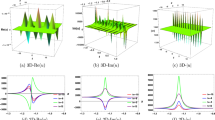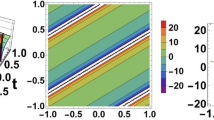Abstract
This research employs recent and precise computational techniques to identify new and accurate solitary wave solutions of the modified Korteweg-de Vries-Kadomtsev-Petviashvili (KdV-KP) equation. The KdV-KP equation is a nonlinear partial differential equation that characterizes the evolution of waves in diverse physical systems, including nonlinear optics, fluid dynamics, and plasma physics. The equation generalizes the KdV and KP equations, which are fundamental models in their respective fields. Physically, the modified KdV-KP equation describes wave propagation where the effects of nonlinearity and dispersion can produce intriguing and complicated wave phenomena such as wave turbulence and solitary waves. The equation has numerous real-world applications, including modeling shallow water waves such as tsunamis and river waves in fluid dynamics, describing the behavior of plasma waves in fusion reactors and astrophysical plasmas, and studying the propagation of light in nonlinear media such as optical fibers in nonlinear optics. One of the most significant applications of the equation is in the study of solitons, which are self-sustaining solitary waves that preserve their shape and velocity even after colliding with other solitons. Solitons are used in various applications such as optical communications, where they transmit information over long distances without distortion, and in fluid dynamics, where they model long-lasting waves in the ocean. The study’s importance lies in its impact on the utilization of the modified KdV-KP equation in diverse fields of physics, including fluid dynamics and plasma physics. The effectiveness of the proposed techniques is demonstrated by comparing them with other computational methods, indicating their superiority.






Similar content being viewed by others
Data and materials availability
The data that support the findings of this study are available from the corresponding author upon reasonable request.
References
Ali, A.T., Khater, M.M., Attia, R.A., Abdel-Aty, A.-H., Lu, D.: Abundant numerical and analytical solutions of the generalized formula of Hirota-Satsuma coupled KdV system. Chaos, Solitons Fractals 131, 109473 (2020)
Alotaibi, H.: Explore optical solitary wave solutions of the KP equation by recent approaches. Curr. Comput.-Aided Drug Des. 12(2), 159 (2022)
Ata-ur-Rahman, A.U.R., Ali, S., Moslem, W.M., Mushtaq, A.: Two-dimensional cylindrical ion-acoustic solitary and rogue waves in ultrarelativistic plasmas. Phys. Plasmas 20(7), 072103 (2013)
Attia, R.A., Xia, Y., Zhang, X., Khater, M.M.: Analytical and numerical investigation of soliton wave solutions in the fifth-order KdV equation within the KdV-kP framework. Results in Physics 51, 106646 (2023)
Bai, C.-L., Bai, C.-J., Zhao, H.: A new generalized algebraic method and its application in nonlinear evolution equations with variable coefficients. Z. Naturforschung Teil A 60(4), 211–220 (2005)
Bar, D.E., Nepomnyashchy, A.A.: Stability of periodic waves generated by long-wavelength instabilities in isotropic and anisotropic systems. Physica D 132(4), 411–427 (1999)
Batool, N., Masood, W., Siddiq, M., Jahangir, R.: Exact solution of CKP equation and formation and interaction of two solitons in pair-ion-electron plasma. Phys. Plasmas 23(8), 082306 (2016)
Cheng, Y., Li, Y.-S.: The constraint of the Kadomtsev-Petviashvili equation and its special solutions. Phys. Lett. A 157(1), 22–26 (1991)
Duan, W.-S.: Stability of dust acoustic waves in weakly two-dimensional dust plasma with vortex-like ion distribution. Chin. Phys. Lett. 19(4), 452–455 (2002)
Feng, W., Zhao, S.: The Sylvester equation and Kadomtsev-Petviashvili system. Symmetry 14(3), 542 (2022)
Gómez-Ullate, D., Lombardo, S., Mañas, M., Mazzocco, M., Nijhoff, F., Sommacal, M.: PREFACE integrability and nonlinear phenomena integrability and nonlinear phenomena. J. Phys. A Math. Gen. 43(43), 430301 (2010)
Guo, D., Tian, S.-F., Zou, L., Zhang, T.-T.: Bright soliton solutions, power series solutions and travelling wave solutions of a (3+1)-dimensional modified Korteweg-de Vries-Kadomtsev-Petviashvili equation. Mod. Phys. Lett. B 32(6), 1850082 (2018)
Han, G., Li, X., Zhao, Q., Li, C.: Interaction structures of multi localized waves within the Kadomtsev-Petviashvili I equation. Physica D 446, 133671 (2023)
Hirota, R.: Discrete analogue of a generalized Toda equation. J. Phys. Soc. Jpn. 50(11), 3785 (1981)
Johnson, M. A., Zumbrun, K.: transverse instability of periodic traveling waves in the generalized Kadomtsev-Petviashvili equation, arXiv e-prints (2009) arXiv:0909.1857
Khan, K., Salam, M.A., Mondal, M., Akbar, M.A.: Construction of traveling wave solutions of the (2+ 1)-dimensional modified KdV-KP equation. Mathematical Methods in the Applied Sciences 46(2), 2042–2054 (2023)
Khater, M.M.: Recent electronic communications; optical quasi-monochromatic soliton waves in fiber medium of the perturbed Fokas-Lenells equation. Opt. Quant. Electron. 54(9), 586 (2022)
Khater, M.M.: Nonparaxial pulse propagation in a planar waveguide with Kerr-like and quintic nonlinearities; computational simulations. Chaos, Solitons Fractals 157, 111970 (2022)
Khater, M.M.: De Broglie waves and nuclear element interaction; abundant waves structures of the nonlinear fractional phi-four equation. Chaos, Solitons Fractals 163, 112549 (2022)
Khater, M.M.: Multi-vector with nonlocal and non-singular kernel ultrashort optical solitons pulses waves in birefringent fibers. Chaos, Solitons Fractals 167, 113098 (2023)
Khater, M.M.: In solid physics equations, accurate and novel soliton wave structures for heating a single crystal of sodium fluoride. Int. J. Mod. Phys. B 37(07), 2350068 (2023)
Khater, M.M.: Physics of crystal lattices and plasma; analytical and numerical simulations of the Gilson-Pickering equation. Results in Physics 44, 106193 (2023)
Khater, M.M.: Hybrid accurate simulations for constructing some novel analytical and numerical solutions of three-order GNLS equation. International Journal of Geometric Methods in Modern Physics 20, 2350159 (2023)
Khater, M.: Advancements in computational techniques for precise solitary wave solutions in the (1+ 1)-dimensional Mikhailov-Novikov-Wang equation. Int. J. Theor. Phys. 62(7), 1–19 (2023)
Khater, M.M.: Computational simulations of propagation of a tsunami wave across the ocean. Chaos, Solitons Fractals 174, 113806 (2023)
Khater, M.M., Lu, D., Attia, R.A.: Lump soliton wave solutions for the (2+ 1)-dimensional Konopelchenko-Dubrovsky equation and KdV equation. Mod. Phys. Lett. B 33(18), 1950199 (2019)
Khater, M.M., Xia, Y., Zhang, X., Attia, R.A.: Waves propagation of optical waves through nonlinear media; modified Kawahara equation. Results in Physics 52, 106796 (2023)
León-Ramírez, A., González-Gaxiola, O., Chacón-Acosta, G.: Analytical solutions to the Chavy-Waddy-Kolokolnikov model of bacterial aggregates in phototaxis by three integration schemes. Mathematics 11(10), 2352 (2023)
Liu, P., Fu, P.-K.: Modified (2+1)-dimensional displacement shallow water wave system and its approximate similarity solutions. Chin. Phys. B 20(9), 090203 (2011)
Liu, Y., Gurram, C.S.: The use of he’s variational iteration method for obtaining the free vibration of an Euler-Bernoulli beam. Math. Comput. Model. 50(11–12), 1545–1552 (2009)
Lou, S.Y., Hu, X.B., Liu, Q.P.: Duality of positive and negative integrable hierarchies via relativistically invariant fields. J. High Energy Phys. 2021(7), 58 (2021)
Mannan, A., Dohnal, T.: (3 + 1)-Dimensional cylindrical Korteweg-de Vries equation in a self-gravitating degenerate quantum plasma system. Phys. Plasmas 27(1), 012102 (2020)
Momani, S., Abuasad, S.: Application of he’s variational iteration method to Helmholtz equation. Chaos, Solitons Fractals 27(5), 1119–1123 (2006)
Muraved, N. N.: A Note on “M - component nonlinear evolution equations: multiple soliton solutions”, arXiv e-prints (2010) arXiv:1009.0443
Oswaldo, G.-G., Alejandro, L.-R., Guillermo, C.-A.: Application of the Kudryashov method for finding exact solutions of the Schamel-Kawahara equation. Russian J. Nonlinear Dyn. 18(2), 203–215 (2022)
Ratliff, D.J., Bridges, T.J.: Reduction to modified KdV and its KP-like generalization via phase modulation. Nonlinearity 31(8), 3794 (2018)
Ryutova, M.: Magnetic solitons, soviet. J. Exp. Theor. Phys. 127(5), 912–921 (2018)
Taghizadeh, N., Mirzazadeh, M., Farahrooz, F.: Exact soliton solutions of the modified KdV-KP equation and the burgers-KP equation by using the first integral method. Appl. Math. Model. 35(8), 3991–3997 (2011)
Taghizadeh, N., Mirzazadeh, M., Farahrooz, F.: Exact soliton solutions of the modified KdV-KP equation and the burgers-KP equation by using the first integral method. Appl. Math. Model. 35(8), 3991–3997 (2011)
Tarofder, S., Mannan, A., Mamun, A.A.: Solitary wave solution of (3+1)-dimensional cylindrical Kadomstev-Petviashvili equation in warm opposite polarity dusty plasma. Results Phys. 49, 106530 (2023)
Tatari, M., Dehghan, M.: On the convergence of he’s variational iteration method. J. Comput. Appl. Math. 207(1), 121–128 (2007)
Wang, K.-L.: New solitary wave solutions of the fractional modified KdV-kadomtsev-Petviashvili equation. Fractals 31(03), 2350025 (2023)
Xuan, H.-N., Lia, B.: Symbolic computation and construction of soliton-like solutions of some nonlinear evolution equations. Z. Naturforschung Teil A 58, 167–175 (2003)
Zhang, D.-j.: Wronskian solutions of integrable systems, arXiv e-prints (2019) arXiv:1903.09283
Zhao, S.-l., Shen, S.-f., Feng, W.: Kadomtsev-Petviashvili system and reduction: generalized Cauchy matrix approach, arXiv e-prints (2014) arXiv:1404.3043
Funding
No fund has been received.
Author information
Authors and Affiliations
Contributions
All the study has been done by the author himself (MMAK).
Corresponding author
Ethics declarations
Conflict of interest
The authors declare that they have no competing interests.
Ethical approval
Not applicable.
Additional information
Publisher's Note
Springer Nature remains neutral with regard to jurisdictional claims in published maps and institutional affiliations.
Appendix
Appendix
Here, we explain the highlights of the above–employed analytical (Khater II) method and approximate (variational iteration) method.
1.1 Khater II method (Khater 2023a, 2022a, b, 2023b, c, 2022c, 2023d, e; Khater et al. 2023; Khater 2023f)
This section gives the Khater II method’s headlines where it is first time to be used as follows:
Assume the following form for the equation of nonlinear evolution:
where \({\mathcal {G}}={\mathcal {G}}(x,t)\) is a polynomial of \({\mathcal {U}}(x,t)\) and its partial derivatives wherein the highest order derivatives and nonlinear terms are concerned. The main steps of the employed method are as follows
Step 1. The traveling wave transformation
converting Equation (A1) into the following ODE
where \({\mathcal {C}}\) is a polynomial in \({\mathcal {U}}(\xi )\) and its total derivatives, wherein \(\varphi ^{\prime }(\xi )=\frac{d \varphi }{d \xi }\).
Step 2. We suppose the solution of (A3) is of the form
where \(a_{i},\, b_{i}\,(i=0,1,2,3, \ldots ,n)\) are arbitrary constants to be determined, such that \(a_{n} \ne 0\), and \(\phi (\xi ), \, f(\xi )\) satisfies the following equation
where \(\delta \) is arbitrary constant. While \(f(\xi )\) and \(\phi (\xi )\) have the following form
Step 3. We determine the positive integer n come out in the suggested general solution by considering the homogeneous balance between the highest order derivatives and the highest order nonlinear terms occurring in (A3) as following
Step 4. We compute all the required derivatives \({\mathcal {V}}^{\prime },\, {\mathcal {V}}^{\prime \prime },\, \ldots \), and substitute (A4) and the derivatives into (A3) and then we account for the function \(\phi (\xi ), \, f(\xi )\). As a result of this substitution, we obtain a polynomial of \(\phi (\xi ), \, f(\xi )\) and its derivatives. In this polynomial, we equate all the coefficients to zero. This procedure yields a system of equations whichever can be solved to find \(a_k\) and \(\phi (\xi ), \, f(\xi )\).
1.2 \(\mathcal{V}\mathcal{I}\) method (Momani and Abuasad 2006; Tatari and Dehghan 2007; Liu and Gurram 2009)
Here is a general nonlinear differential equation, which illustrates the basic concept of He’s variational iteration method:
where \({\mathcal {L}},\, {\mathcal {N}},\, g(x,t)\) are respectively describe a linear operator, a nonlinear operator, and a known analytical function. According to the variational method, a correction functional can be constructed as follows:
In this case, \(\varsigma \) denotes a general Lagrange multiplier that can be identified optimally using variational theory, and \(\tilde{{\mathcal {U}}}_{\rho }\) represents a restricted variation, i.e. \(\delta \, \tilde{{\mathcal {U}}}_{\rho }=0\). The stationary conditions
This in turn gives
Using He’s variational iteration technique to the investigated model for investigating the model’s approximate solution, gets the following values of the analytical, numerical, and absolute difference between these two values.
Rights and permissions
Springer Nature or its licensor (e.g. a society or other partner) holds exclusive rights to this article under a publishing agreement with the author(s) or other rightsholder(s); author self-archiving of the accepted manuscript version of this article is solely governed by the terms of such publishing agreement and applicable law.
About this article
Cite this article
Khater, M.M.A. Advanced computational techniques for solving the modified KdV-KP equation and modeling nonlinear waves. Opt Quant Electron 56, 6 (2024). https://doi.org/10.1007/s11082-023-05581-3
Received:
Accepted:
Published:
DOI: https://doi.org/10.1007/s11082-023-05581-3




